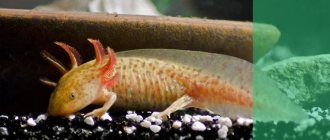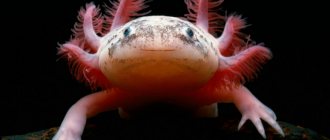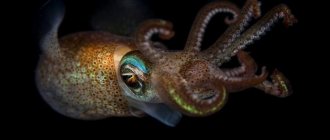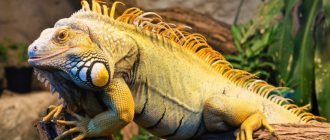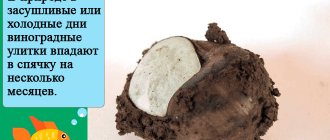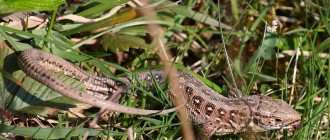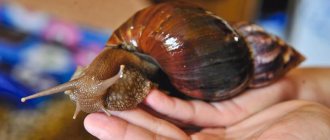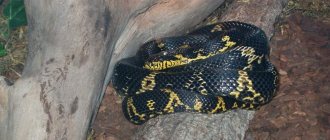An amazing creature that reminds some of a dragon, others of the “cartoon” Luntik. Many people think he's cute, but some don't like him at all and consider him scary and disgusting.
It perfectly adapts to both its natural habitat and life in captivity, swimming carefree at the bottom of the aquarium. What species is it classified as: fish, lizard or newt?
We will try to clarify who the axolotl is in our article.
Axolotl description
Axolotl (in Latin Axolotl) is the larva of some species of ambist.
Ambystoma are a genus of amphibians belonging to the order of salamanders. Outwardly, they resemble lizards. Ambystoma live throughout North America, from Mexico to Canada.
Axolotls can exist perfectly well without turning into adults. They hunt well and reproduce while in the initial period of their life.
This is because their thyroid gland does not produce enough thyroxine, a hormone that is responsible for the growth and development of the body. Therefore, axolotls can remain forever young. This property is called “neoteny,” which translated from ancient Greek means “extended youth.”
When we talk about an axolotl, we generally mean the larva of the Mexican Ambystoma - the Mexican axolotl. This is one of the most common types of this amphibian.
Scientific classification
According to scientific nomenclature, the axolotl occupies the following place in the taxonomy:
- Domain: Eukaryotes.
- Kingdom: Animals.
- Subkingdom: Eumetazoa.
- Type: Chordata.
- Class: Amphibians.
- Order: Tailed amphibians.
- Family: Ambystomaceae.
- Genus: Ambystoma.
- Species: Axolotl.
Photo: Axolotl
Origin story
Lakes Chalco and Xochimilco, which are located in Mexico, are considered to be the homeland of axolotls.
They were found there during the reign of the Aztecs.
This is interesting
It was the Aztecs who came up with the name "axolotl"
Translated from their language it meant “river monster.” The ancient Indians ate axolotls, considering them a delicacy. But even now modern Mexicans are not averse to eating these larvae.
But in Europe, axolotls appeared in the second half of the 19th century. Most likely they were brought by one of the fishing vessels.
In 1985, the first individuals were bred in captivity in the History Museum in Paris. And soon their active spread on the European continent began.
Various types of ambisto larvae have been bred, including the golden axolotl, harlequin, albino axolotl, and white axolotl.
Moreover, the latter two are often confused with each other due to identical skin color. Only albinos have white skin with a pink tint, while white axolotls have a matte white body. Albinos have red eyes, light gills with bright scarlet hairs. White axolotls have black eyes and dark gills with pink hairs.
In the XIX - early XX centuries. Ambistoma larvae, which were created in the laboratory, were used for research and experiments, but now they are used only for decorative purposes, released into home aquariums.
Appearance
Externally, the axolotl resembles a small dragon. Therefore, it is often also called a water dragon or a water lizard.
Axolotls are quite large larvae.
- The size of an axolotl is about 30 cm.
- The body has an elongated shape with a wide and long tail.
- A dorsal fin, similar to a crest, runs along the body.
- There are 4 small paws
- The head is wide and has fluffy external gills.
- The mouth is wide, so it seems that the water dragon is smiling all the time.
- The eyes are small, bead-like, located in front.
This is interesting
The number of toes on the paws is not the same: there are 4 toes on the front and 5 on the back
Natural habitat
In the wild, the water dragon lives in the canal system of Mexico's Lake Xochimilco. It is located within the city of Mexico, at an altitude of about 2 thousand meters above sea level.
The second habitat of axolotls, Lake Chalco, has long since dried up.
Axolotls live underwater, and although they are classified as amphibians, no one has ever seen them on land.
Axolotls are also found in water bodies of the USA and Canada. It is in those areas that the amphibian ambystoma are most common.
Ambystoma larvae settle in deep pools where dense vegetation predominates. They love cool weather. Therefore, the temperature of the water where water dragons live does not exceed 13 oC
Important!
Now the axolotl is an endangered species of animal, its natural population is on the verge of extinction.
Lifestyle and behavior
Axolotls are predators. They eat zooplankton, aquatic insects and fish fry. They swallow their prey whole, digesting it for 2-3 days.
Axolotls also often bite off the limbs of their relatives. Moreover, the injured axolotl will eventually grow back the lost part of the body. This amazing ability of water dragons to regenerate allows them to restore not only their paws, but also damaged lungs and even their brain.
Axolotls are active at night when they begin to hunt. They spend the rest of the time lying motionless on the bottom or hanging in the water column.
They have very poor eyesight. Therefore, they mainly use other senses. They feel fluctuations in water and changes in pressure with their delicate skin.
Axolotls move by scooping up water with their front paws. The tail is also involved, which sets the trajectory of movement.
If the water where the axolotl lives is clean, then it breathes through gills. If the reservoir is dirty and there is little oxygen in it, then the water dragon uses its lungs. When returning to clean water, the axolotl again begins to breathe through its gills.
Feeding
The axolotl is a nocturnal predator. The basis of its diet when kept in an aquarium should be protein food.
Suitable for these purposes:
- worms;
- cockroaches;
- crickets;
- mussels;
- shrimps;
- crustaceans;
- bloodworm;
- live fish (with caution to prevent contamination);
- dry food for predatory aquarium inhabitants.
Any meat from mammalian species is strictly prohibited. The axolotl's gastrointestinal system is designed in such a way that it is not able to digest such protein.
Under no circumstances should water dragons be overfed, but they should not starve either, they become aggressive.
When feeding the axolotl, you need to get him interested in the food, because if it doesn’t move, he may not notice it. Therefore, the water dragon is often fed by hand or using special tweezers.
In addition, the axolotl's eyes are designed in such a way that they can only look up; they cannot see what lies at the bottom.
With its jaws, this pet is able to grab even a large fish and, holding it, gradually swallows it whole. It will take the dragon several days to digest such prey. Therefore, adult individuals are usually fed to their fullest, but once every 2-3 days.
If you feed an axolotl every day, it will eat without stopping; this species is prone to overeating. But in fact, they are capable of fasting for almost a month.
Interesting Facts
There are a number of interesting facts and features that are characteristic of ambisto larvae
How to distinguish a female from a male
The female's body is slightly wider than the male's body.
In males, the cloaca area appears to be swollen. Females do not have this sign.
Adult sizes
As a rule, in the wild, axolotls grow up to 30 cm in length, but large individuals measuring 45 cm are also found.
Axolotls living in an aquarium have more modest parameters. They grow no more than 23 cm.
How an axolotl turns into an ambistoma
An axolotl can live its entire life without ever moving from the larval stage to the adult animal stage. Only environmental changes can influence its transformation. This usually happens when the water level in the place where the axolotl lives drops critically.
The transformation lasts on average 3-4 weeks. During this time, the larva loses its external gills and changes shape and color. Her dorsal ridge disappears, her tail becomes more rounded. This is how an axolotl becomes an ambistoma.
Basic aquarium parameters
The size of axolotls is quite impressive, so the recommended minimum aquarium volume is about 60-80 liters. In this case, the aquarium does not have to be full: the water level should be higher than the length of your pet. It is advisable to use a filter - otherwise frequent water changes are necessary. The filter should not create a strong current. It is necessary to regulate the power of the device so as not to damage the axolotl’s gills.
A siphon should be used to remove food residues from the bottom. A weekly 20% water change is also necessary. In aquariums without a filter, replacements of the same volume are necessary daily or every other day. A complete water change is unacceptable, as this can lead to a total imbalance in the aquarium. Tap water usually contains chlorine compounds. They can be neutralized using special preparations for aquarium water on the market. Optimal pH values are 6.5-7.5.
Varieties
In nature, there are more than 30 species of ambisto. The most common are Mexican and tiger ambystoma.
Tiger Ambystoma Axolotl
Tiger Ambystomas live on the shores of reservoirs from Mexico to Canada. Their length, including the tail, is 28 cm. The skin color of the amphibian varies from dark brown to olive green. Yellow stripes are scattered throughout the body, hence the name “brindle”.
Tiger axolotls are often kept as aquarium pets. Albinos, individuals that were bred artificially, are very popular.
Marbled axolotls
A distinctive feature of marbled ambistos is their strong build and silver stripes on black skin. This species of ambistom does not grow more than 12 cm.
Marbled axolotls undergo a full transformation cycle in 2-6 months, depending on environmental conditions. They feed on daphnia, cyclops and other zooplankton.
Mole-shaped Ambystoma
These are one of the smallest ambistos. Their size is only 9 cm. Their tail is short. The head is wide and flattened. Almost all the time, the bloody ambystoma is busy digging the ground. Hence its name.
Pacific Ambystoma
And these are large amphibians. Their body length can reach 34 cm. They hunt snails and slugs, other amphibians, and also like to eat small rodents.
They live in deep burrows, where they hide from heat and bright light. When in danger, they make sounds similar to a growl. They can also bite painfully.
Olympic ambistomes
Named after the place where they live, the Olympic Peninsula, Washington State. They live on the banks of mountain rivers, in places covered with moss and shaded by coniferous trees. In rainy weather, Olympic Ambistos can be seen far from the reservoir.
The larvae of this species of Ambystoma settle in reservoirs with a rocky bottom.
Olympic ambystoms feed on beetles, flies, and earthworms.
The skin color of these amphibians is yellow, with small brown spots that cover almost the entire body.
Mexican Ambystoma
The most common type of ambistom. Lives in the lakes of Mexico. The adult is black or black-brown in color. This shade helps it blend into the bottom of the reservoir, hiding from enemies or hunting prey.
The larva of the Mexican Ambystoma is the black axolotl, which became the progenitor of many species of ornamental axolotls. It is this larva that can most often be seen in home aquariums.
Keeping at home
Keeping an axolotl is not particularly difficult. Many aquarists keep axolotls at home. Domestic Ambist larvae are called aquarium dragons.
But in order for the axolotl to take root in the aquarium, you need to take into account a number of features.
Compatibility with fish
Do not forget that axolotls are predators. In some cases, they attack relatives and eat their own kind. If it is not possible to provide each axolotl with separate living space, then the breeder should try to ensure that they are the same in size and age.
It is also prohibited to keep water dragons with aquarium fish. Firstly, the fish can gnaw on the delicate gills of the axolotl, and they, in turn, will eat the small fish. And secondly, they have completely different requirements for temperature conditions and water hardness.
This is interesting
Some aquarists keep guppy fish with axolotls. The fry of the latter serve as food for the water dragon.
Choosing an aquarium
When buying an aquarium for an axolotl, the breeder must take into account that there must be at least 50 liters of water per larva. The depth of the aquarium should be about 30 cm.
It is better to take rectangular-shaped containers, elongated in length. It will be easier for axolotls to move in them.
Aquarium equipment
A filter is installed in the aquarium where the axolotl will live. It will keep the water clean and also provide a slight current.
It is also necessary to hang a thermometer, with which the breeder will monitor the temperature of the water in the container.
A compressor is also usually installed. Although ambystoma larvae do not particularly need additional aeration, if there is a lack of oxygen, they float to the surface.
But still, axolotls feel better when the water is saturated with oxygen. Then the water dragons behave calmer and get sick less.
Water requirements
The water in which the aquarium dragon lives should be slightly hard, with an alkaline pH of 7-8. If tap water is used, it must be left for 2-3 days.
The temperature in the aquarium varies between 19-21 oC. If the water is warm, the axolotl's respiratory system will be the first to suffer. The gills become infected with a fungus and die. In the summer heat, you even have to add ice to the aquarium for axolotls. But if possible, it is better to use a special cooling system.
It is worth changing a third of the water in the aquarium weekly. Axolotls get sick and die from dirty water. Also, any remaining food that the water dragon has not eaten must be removed from the water.
Light
Since the axolotl is predominantly nocturnal, it does not need additional lighting.
But due to the fact that the larva has poor eyesight, it is better to create dim lighting that will softly highlight the algae in the aquarium.
Priming
The bottom of the aquarium can be covered with sand or large pebbles. Walking along large rocks, the axolotl examines the bottom in search of food.
Small pebbles should not be used. The axolotl will definitely want to taste them, or accidentally swallow them with the main food. This will lead to disastrous consequences.
Some breeders leave the bottom of the container bare without using any soil. At the same time, their pets do not experience significant discomfort.
Plants
An aquarium where axolotls live must have plants. Cladophora, hornwort, anubias, and hydrophila are suitable. They tolerate cool water well, which axolotls need.
Aquatic dragonets love to rest, hiding in algae. Plants are also needed during the breeding season. The female attaches the fertilized eggs to the leaves.
You can supplement the aquarium with pistia and riccia. They float on the surface and create additional shadow
Shelters
This amphibian prefers twilight, and always tries to hide somewhere. As a shelter at the bottom of the aquarium for the axolotl, you need to place pots, grottoes, and you can build small holes.
You just need to make sure that the surface of the shelter elements is smooth and without sharp corners. Otherwise, the axolotl may get hurt.
Aquarium placement
Since the animal does not like bright light, it is better to place the aquarium away from the window. To prevent the water from heating up, the container is placed away from central heating radiators and isolated from direct sunlight.
Good to know
Some breeders send containers with axolotls to the basement for the summer.
Compatibility with other fish
The animal's proximity to other aquatic inhabitants is, in principle, tolerable - the main thing is that they are fish the size of an axolotl. But this is not the only condition. For example, oxalates (photo) tend to eat their neighbors.
The experience of breeders shows that goldfish provide the most comfortable companionship for amphibians. There is no less chance of “squabbles” with them, they do not bite the gills of the “baby dragon”, and amphibians, on the contrary, have little interest in fish, since they are large enough to fit into their mouth.
In addition, golden inhabitants are adapted to cool water. But there is no science that could take into account the character and individuality of each goldfish - there is always the possibility of conflictual cohabitation, even to the point of eating soft axolotl larvae.
Attention! Amphibians hunt effectively, despite the fact that they see only what is at the level of their body.
If selected incorrectly, the amphibian may feed on its neighbors, or the fish themselves may injure it. An important factor when trying to accommodate neighboring guests is the temperature of the water in which all individuals will feel comfortable. After all, not all fish can exist in the conditions to which ambystoms are accustomed.
Photo: Marbled axolotl
Diseases and their prevention
Axolotls develop a number of diseases from poor nutrition: intestinal obstruction, anorexia, and pathology of cartilage tissue.
Intestinal obstruction develops when the amphibian swallows large grains of sand and pebbles. As a result, she stops eating and rapidly loses weight. In this case, a veterinarian examination and possibly surgery are necessary.
To avoid this situation, it is better to cover the bottom of the aquarium with large pebbles that the animal cannot swallow.
Pathology of cartilage tissue develops from a lack of calcium and vitamin D. Here you need to adjust the axolotl’s diet so that along with food it receives the necessary vitamins and microelements.
Anorexia in axolotls occurs from poor nutrition, as well as from infectious processes that occur in the body. For example, from intestinal parasites. The water dragon refuses to eat and its body swells. To cure the larva, experts recommend feeding it with ground egg yolk and granulated flower pollen.
Attention!
If the water is dirty and has a high chlorine content, the axolotl may develop ascites. Due to bacteria entering the body, the animal's metabolism is disrupted and it may die.
During treatment, it is better to place the sick axolotl in a separate container. The doctor will prescribe the necessary antibiotics, diuretics and other necessary medications.
It is also not recommended to constantly handle the axolotl. His body is tender and soft, there are no bones in it. Therefore, it is very easy for an aquarium dragon to be injured.
Many people wonder: what to feed the axolotl so that it does not get sick, what diet should it be given so that it has enough all the microelements.
Axolotls feed on bloodworms and live crickets. They will not refuse fish fillets and shrimp meat.
Pet stores also sell balanced food for amphibians, which axolotls readily eat.
Ambystoma larvae need to be fed once every 3 days.
Little tricks
For the axolotl, the purity of the water and its oxygen saturation are important, so the aquarium must be equipped with a compressor and cleaned at least once a week. The optimal water temperature is 15-20o. But the flow of larvae is annoying, so the compressor should not be too strong
nym. Axolotls do not like bright light, so it would be good to create shaded areas in the aquarium. As neighbors for them, it is better to select fish that are not small and not too lively - golden ones are great, but not veil ones.
An abrupt replacement of old water with fresh water, especially cold water, is a stimulus for axolotls to reproduce. From the eggs laid by the female on aquatic plants, after a couple of weeks of being kept in a separate container with water, larvae develop, which are fed with food for fish fry.
And lastly: if your axolotl suddenly changed its color and body shape and “threw back” its gills, it means that it has turned into an ambistoma. This happens when the water level drops significantly or when the special hormone thyroidin gets into the food. There is nothing wrong with this, it’s just that you will now have a different pet living with you.
Popular questions and answers
Before getting an axolotl, aquarists study a lot of information. They are mainly interested in questions regarding the lifespan, reproduction and cost of water dragons.
How long does an axolotl live?
Under natural conditions, axolotls live for about 10 years.
In captivity, if the aquarist has provided his pets with the proper conditions and care, ambisto larvae can live up to 20 years.
How to breed an axolotl
Axolotls reach sexual maturity at the age of 1 year, but it is better to wait until individuals are 2-3 years old.
Before breeding, the female and male are placed in different aquariums, keeping them separate for several weeks. In this case, the usual water temperature must be lowered by several degrees. During this period, the larval diet should contain food high in protein.
Afterwards, the axolotls are transferred to a special spawning aquarium. The male deposits spermatophores, and the female collects these clumps of sperm using the cloaca.
A day after fertilization, the female aquarium dragon begins to lay eggs. As a rule, it attaches the eggs to the leaves of algae. At one time, a female axolotl can produce up to 1000 eggs.
After laying eggs, the parents are removed, and the temperature in the aquarium with the eggs is raised to 22 °C. After two weeks, fry hatch from the eggs.
Natural enemies of axolotls
Photo: Amphibian axolotl
Many reasons contributed to the decline in axolotl numbers. One of them is the destruction of natural habitats and pollution of water sources. Changing climatic conditions, warming and rising water temperatures cause death and numerous diseases of amphibians.
The second significant reason for the decline in numbers is diseases, to which salamanders are very susceptible. They tend to suffer from very serious diseases that cause death: ascites, anorexia, metabolic disorders, hypovitamnosis, intestinal obstruction, digestive disorders, etc.
Humans played a major role in the status of the population. Amphibians were caught in huge quantities for the purpose of conducting experiments and research on the regeneration of lost organs and limbs. In addition, human activity contributes to the pollution of natural water bodies. Crystal clear lake water becomes dirty. This leads to sickness and death of water dragons, as they react very strongly to water quality.
In addition, larger and more predatory fish hunted axolotls: telapia, carp. They eat large quantities of not only the amphibians themselves, but also their eggs, which thus do not have time to turn into fry.
